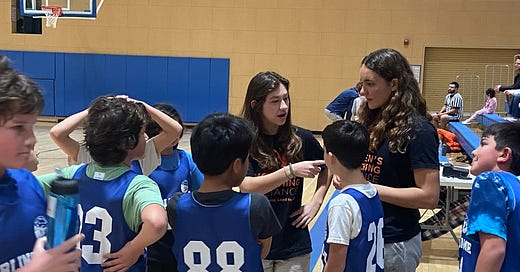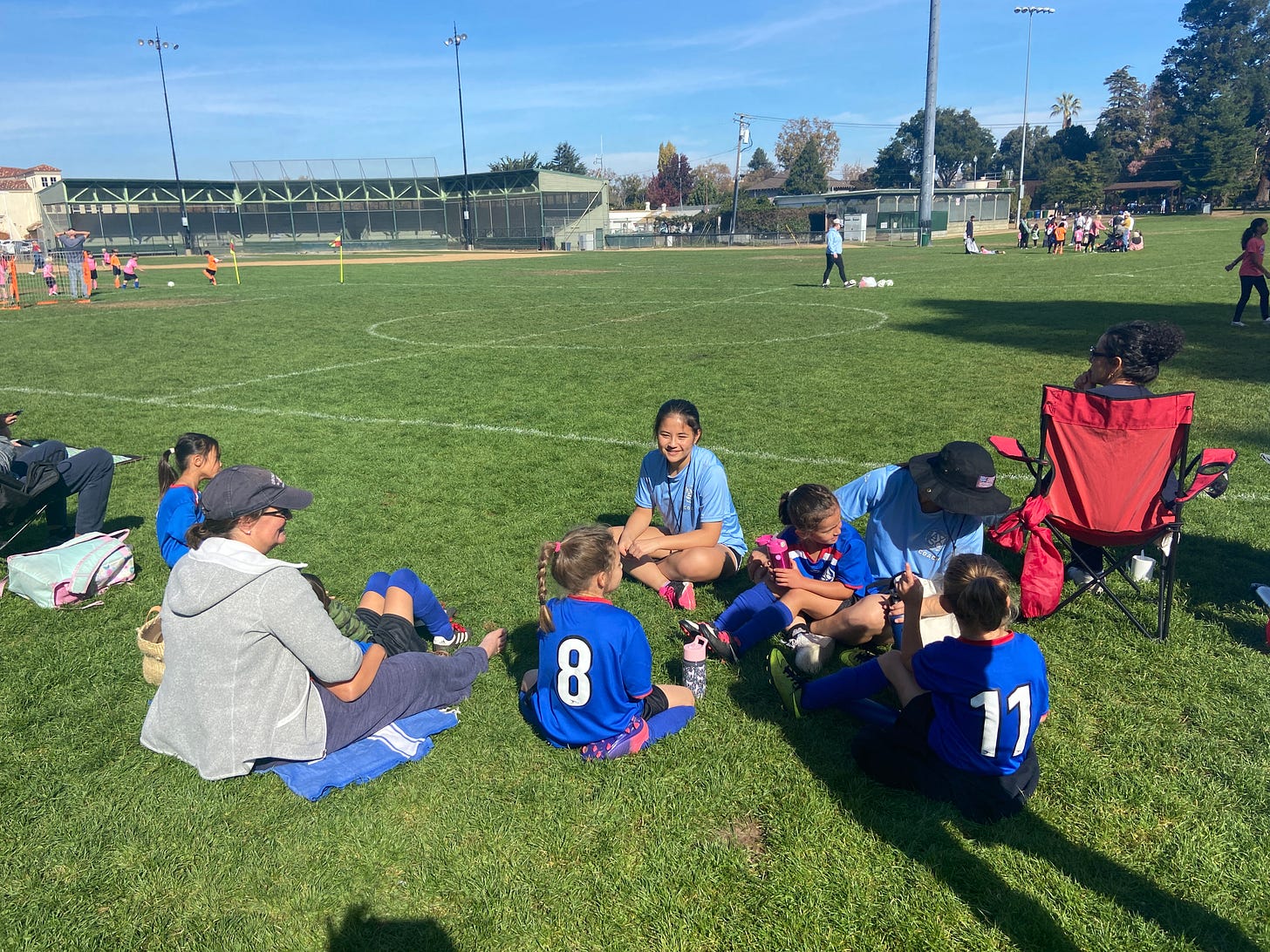Coach Like a Girl
The quest for diversifying the youth sports coaching landscape is full speed ahead!
Before I can ask Pam Baker a substantive question, she has one for me: You mentioned you coach. What sport? I beam, and excitedly tell her how I’m the assistant coach of my younger son’s soccer team. Then, as if on autopilot, I tamper down the volume and add a disclaimer. “BUT…I never played soccer as a kid, and I’m not very good. I thought I was signing up just to tie kids’ shoes except the coach has me play goalie,” I say it with a silly giggle that’s really a defense mechanism, as if the notion of me helping coach 8- and 9-year-olds in any way beyond the rudimentary is absurd. Baker stops me right there. She’s heard enough.
“You sound like every other woman I’ve ever talked to who’s coaching and says, ‘I’m coaching BUT.’ And then we fill it in with all the things we don’t have, and I can tell you, there’s no man I talk to when he says he coaches that gives me a similar disclaimer,” says Baker, who founded Women’s Coaching Alliance (WCA) last summer. “The men just say, ‘sure I’ll coach.’ Even if they never played the sport, they just assume they’ll pick it up.
On the surface, Women’s Coaching Alliance, based in Northern California, was launched to create a pipeline of young female coaches because the current numbers are bleak. In its infancy, WCA is focused on developing young women, ages 15-25, as youth sports coaches. A task easier said than done.
Photo: WCA
On a more global scale, Baker wants to empower these women to shift their mindset before they’re stuck in the same cycles that have long plagued older generations of women. This disparity, the knee jerk where women are compelled to list their bona fides, or what they believe is a lack thereof, is too familiar to Baker. She spent over two decades in health care marketing for companies like Johnson and Johnson and Genentech observing women exhibit the same self-doubt even while climbing the corporate ladder.
Baker was first inspired to connect the dots between early leadership and coaching for young women by her late husband, Doug, who passed away from pancreatic cancer in 2020. He was the product of great coaches throughout his youth who were positive role models, and while he never played soccer, he happily volunteered to coach for their twin daughters. According to Baker, Doug was one of these coaches that just wanted kids out there having fun and forming connections. He just went out and said, ‘I got this.” No disclaimer. He wanted to help empower female coaches to do the same.
Several months after Doug’s passing, Baker started researching what makes a great coach. “I looked at these coaches and realized they’re just great leaders. They’re just doing it in a different realm.” The lightbulbs started to brighten.
The lack of female coaches is hardly a new phenomenon. Given the breadth of youth sports, exact, real-time numbers are hard to come by. But the numbers we have glimpsed in recent years are disheartening:
Just 24% of youth coaches are women (Aspen Institute Project Play, State of Play Report 2020)
A USC study tracked 538 Little League baseball and softball teams and 1,490 American Youth Soccer Organization (AYSO) soccer teams over an eight-year period. Their findings: only 13.4% of the head coaches in AYSO soccer were women, and only 5.9 % of the head coaching slots in baseball and softball were filled by women. (MomsTeam.com)
In the National Youth Coach survey, 17% of men reported coaching female teams most often compared to 8% of women who coach male teams more frequently. (Aspen Institute Project Play, State of Play 2022 )
Then there’s just the anecdotal evidence. You take your kid to a volleyball tryout or a basketball tryout and most of the coaches are male. Same when you look at most coaching slates, especially at the higher levels and older age groups. Maybe it seems fine, even “normal,” but what is happening is these young athletes are being deprived of exposure to more personalities and leadership styles.
The widespread intent to boost the number of female coaches is increasingly there but the execution, at least to date, has been lacking.
For most of the history of youth sports (and the world), women have simply been an afterthought despite playing experience and/or inherent leadership qualities. Perhaps a few women respond when there’s a call for coaches. But when there are still openings, how many are asked to coach? The evidence points to very little which is only feeding into archaic gender stereotypes. Men coach. Women become the team manager. All this split does is keep the self-doubting afire. In her book, Lean In, Sheryl Sandberg noted a finding that women feel they must be 100% qualified before applying for a position or asking for a raise, whereas men deem themselves qualified if they only check 60% of the boxes. Turns out that was an aside from a Hewlett-Packard executive, but the confidence gap is real. The women think, I don’t know enough. I didn’t play long enough. I didn’t play at an elite enough level. The men believe they can just figure it out because that’s what society has told them.
There are plenty of organizations trying new avenues to change the narrative and create more diverse coaching staffs.
Baker notes that AYSO (American Youth Soccer Organization, a national soccer outfit) has a goal of 50% women coaches but have fallen well short. They started by trying to recruit moms to coach but it didn’t yield great results. Maybe they didn’t believe they were qualified, or maybe had no room in the stressful schedule inherent with motherhood. Thus, AYSO pivoted to a group that had ample time on their hands, retirees. But that didn’t click either as many retirees said they were working on their bucket list and coaching youth sports wasn’t on it.
24-7 UK Soccer Academy, a competitive and recreational soccer club in Northern California, just hired a women’s development director, former player and collegiate coach Anne Whipple, to recruit more female coaches.
“Having more female coaches in soccer is more than just ticking a box,” says Dan Chubbock, one of the club’s Directors of Coaching. “It is important for young players to see females in leadership positions and be in an environment where they are comfortable. Having someone that has been where they are and able to empathize when they have struggles is key to continued participation.”
[Full disclosure: My kids are part of 24-7 and learning about this new hire was part of the impetus for me exploring this gap.]
Baker agrees. “Women bring a different and complementary set of skills to coaching and leadership. The data is clear in companies, boardrooms, etc. that more diverse leadership teams get better results.”
This sentiment is reverberating across the entire sports landscape. The NFL has been particularly successful via their annual Women’s Forum that started in 2017 as a mechanism to connect qualified women in football operations with NFL rainmakers. The first season only one club general manager and coach showed up; this past February, all 32 clubs were not only in attendance but competing to hire the top candidates.
To build a pipeline, you must start with willing participants. When Baker talked to young women who had played a sport, very few had women coaches. When they did, they said it was really impactful. They too were interested in giving back except they unanimously were turned off by the same thing - dealing with difficult parents.
Baker empathized with them but also saw their concerns as a major growth opportunity.
“Dealing with different parents is like dealing with difficult bosses and vendors and co-workers. Imagine learning how to navigate those difficult situations when you’re 18 instead of 30,” she said. That was the sell and became the premise of WCA.
As Baker points out, there are a multitude of parallels between coaching and leading in other realms. A coach might alter a game plan because the other team comes in with an unexpected formation. That’s adaptability. A coach needs to figure out how to connect with every kid on the team. That’s developing good communication skills.
Much like the NFL heavily prepares the women they invite to the forum, Baker is also setting up her young women for success.
WCA tools women coaches with everything they need, such as developing an 8-week practice plan and incorporating positive youth development principles. They also attend a leadership academy. Typically, two women coach together and are paired with a mentor they can lean on. And of utmost importance to Baker and her quest for these women to understand their self-worth early on, she pays them via a fund set up through the Parks and Rec department in Burlingame, CA.
“As a mom, I’ve hired many babysitters and dogwalkers, most of them female,” Baker says. “When I ask their rate, they get sheepish. It’s a big factor in the gender wage gap and we’re on a mission to shrink that.”
Photo: WCA
WCA is solely focused on placing young coaches at the rec level at this point, and currently have coaches in cross-country, volleyball, soccer, and basketball. They’ll be adding flag football in the summer in preparation for it being an officially sanctioned high school sport this fall. WCA will be hosting a flag football clinic so the women can play and get a deeper feel for the sport and its rules. Again, being prepared is key.
It's still early, but the WCA model is gaining fast traction. The Golden State Warriors Youth Academy is looking to them to help build a pipeline of women’s basketball coaches, and the San Francisco 49ers are also interested in forging a relationship. The feedback Baker has received on her young coaches has been exemplary. The athletes find them relatable and admire their preparedness. The parents, including dads who have daughters, love having these women as leaders for their kids.
The more women that are coaching, the more girls are going to play sports, and the more girls and boys will have a variety of role models. And these women will be well-equipped to lead as they head into their careers, be it in coaching or elsewhere. That’s a win for everyone.





